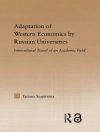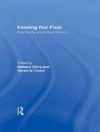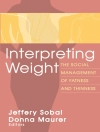Understanding and Improving Prisoner Reentry Outcomes
‘Mass imprisonment and mass prisoner reentry are two faces of the same coin. In a comprehensive and penetrating analysis, Daniel Mears and Joshua Cochran unravel the causes of this pressing problem, detail the challenges confronting released prisoners, and provide an evidence-based blueprint for successfully reintegrating offenders into the community. Scholarly yet accessible, this volume is essential reading—whether by academics or students—for anyone wishing to understand the chief policy issue facing American corrections.’
Francis T. Cullen
Distinguished Research Professor, University of Cincinnati
Prisoner Reentry is an engaging and comprehensive examination of prisoner reentry and how to improve public safety, well-being, and justice in the ‘era of mass incarceration.’ Renowned authors Daniel P. Mears and Joshua C. Cochran investigate historical trends in incarceration and punishment policy, the salience of in-prison and post-prison contexts and experiences for reentry, and the importance of understanding group differences in offending, punishment, and social context. Using extensive reliance on both theory and empirical research, the authors identify how reentry reflects criminal justice policy in America and, at the same time, has profound implications for crime prevention and justice. Readers will develop a diverse foundation for current policies, identify the implications of reentry for families, community, and society at large, and gain a conceptual and empirical toolkit for analyzing and improving the lives of those released from prison.
Содержание
Chapter 1: Introduction
Mass Incarceration and Reentry
The Goals of This Book
Criminological “Versus” Criminal Justice Theory and Research
Terminology and Scope
Organization of the Book
Chapter 2: Historical Trends in Corrections and Reentry Policy and Practice
Trends in Correctional Populations: The Era of Mass Corrections
Trends in Reentry Policy and Practice
The Theory, or Causal Logic, of the Punitive Turn in Sanctioning Convicted Felons
Implications of Historical Trends in Incarceration and Reentry Policy and Practice
Conclusion
Discussion Questions
Chapter 3: The Causes of Mass Incarceration and Thus Mass Reentry
Causal Complexity in Understanding the Punitive Turn
Cause 1: Not Crime
Cause 2: Public Demand for Increased Punitive Sanctioning
Cause 3: Conservatism, Race, Moral Panics, and the Politicization of Crime
Cause 4: Increased Belief in the Idea That Individual Responsibility Matters Most
Cause 5: Exaggerated Claims for Incarceration
Cause 6: Discounting Effectiveness of Non-Incarcerative Sanctions
Cause 7: Inadequate Research Documenting the Need for Specific Types of Sanctions
Cause 8: Economics
Cause 9. Systems-Level Forces and Dynamics
Causal Complexity Revisited
Conclusion, or Why Understanding the Punitive Turn Is Relevant for Reentry Policy
Discussion Questions
Chapter 4: Profile of the Inmate Population
Why Inmate and Ex-Prisoner Characteristics Matter
Inmate and Ex-Prisoner Characteristics
The “Typical Inmate” Profile
Why Inmate Profiles Change Over Time
Conclusion
Discussion Questions
Chapter 5: The Prison Experience
Why What Happens in Prison Is Relevant for Understanding Reentry
The Implications of In-Prison Crime and Misconduct
Prison Experiences that May Have Implications for Prisoner Reentry
How Inmates Perceive Themselves and the Prison Experience and Why It Matters
The (Lack of) Evidence on the Effectiveness of Incarceration
Concepts of What the Prison Experience Should Be
Making Greater Accountability Happen
Conclusion
Discussion Questions
Chapter 6: The Reentry Experience and Reentry Challenges
The Reentry Process and Experience
The Logic of “Invisible” Punishments and Their Consequences
Specific Challenges During Reentry
Implications of Reentry Challenges for Ex-Prisoners and Families and Communities
Conclusion
Discussion Questions
Chapter 7: Recidivism and Risk Prediction
The Atheoretical Foundation of Mass Incarceration
The A Priori, Theoretically Predictable Consequences of Incarceration
Recidivism Rates—A Depressing Problem
Risk Prediction Approaches
Risk Prediction Success
The Challenges of Risk Prediction
Approaches to Improve Risk Prediction
Shifting the Focus of Risk Prediction
Conclusion
Discussion Questions
Chapter 8: Diverse Inmate Populations and Reentry
The Diversity of the Inmate and Ex-Prisoner Population and Why It Matters
The Youngest Ex-Prisoners
Female Ex-Prisoners
Racial and Ethnic Minority Ex-Prisoners
Other Groups of Ex-Prisoners
Super-Maximum Security Ex-Prisoners
Drug-Abusing Ex-Prisoners
Mentally Ill or Learning Disabled Ex-Prisoners
Still Other Groups of Ex-Prisoners
Revisiting Sanctioning and Reentry
Conclusion
Discussion Questions
Chapter 9: Reentry Policy and What Works to Improve Reentry Outcomes
The Ineffectiveness of Incarceration in Improving Public Safety or Other Outcomes
The Ineffectiveness of Incarceration Due to Collateral Consequences
Corrections Efforts Frequently Rest on Weak Theoretical and Empirical Grounds
Minimal Evaluation of Most Reentry Policies, Programs, and Practices
Pre-Prison, In-Prison, and Postrelease Approaches to Successful Reentry
General Guidelines and Strategies for Improving Reentry
The Importance of Evidence of Cost-Efficiency, Not Just Impacts
The Need for an Offender, Victim, and Community Justice System
Reentry Lessons and Convicted Felons Who Don’t Go to Prison
The Importance of Government Accountability and Evidence-Based Practice
Conclusion
Discussion Questions
Chapter 10: Conclusion
Об авторе
Dr. Joshua C. Cochran is an Assistant Professor at the University of South Florida′s Department of Criminology. His research focuses on prison experiences, prisoner reentry, and inequalities that emerge within these areas. He has collaborated with Dr. Mears on a range of studies, including recently two chapters on prisons and prisoner reentry, one for an edited volume published by Springer and the other for an edited volume to be published by Oxford University Press. Recently, he was awarded the American Society of Criminology’s Division on Corrections and Sentencing Dissertation Award for his Ph.D. thesis focused on incarceration and the implications of inmate social ties. His recent work has appeared in leading criminology journals including Criminology, Journal of Research in Crime and Delinquency, Journal of Quantitative Criminology, and Justice Quarterly.












